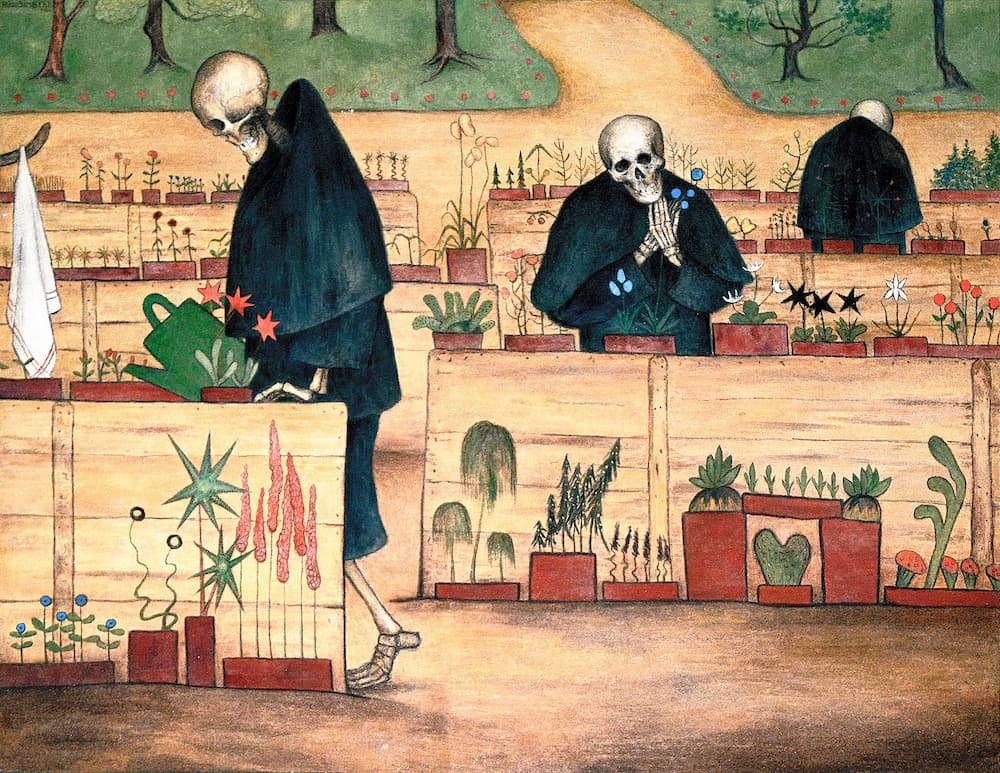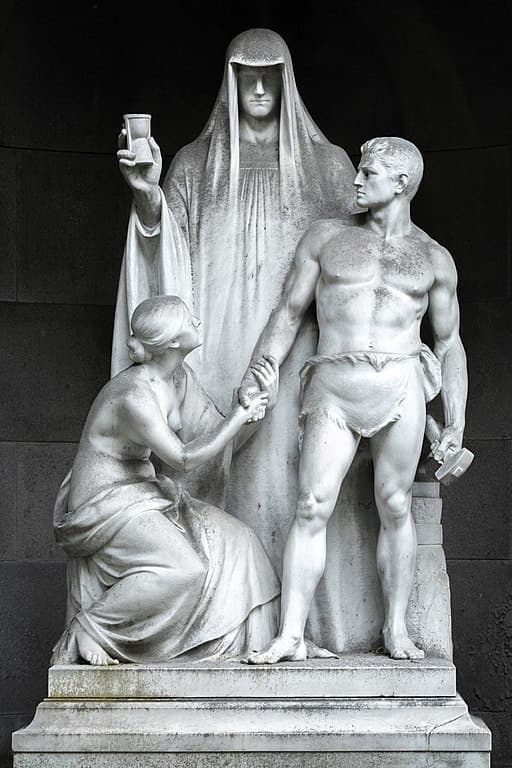Death.
One of the most discussed, and taboo, subjects ever. In recent times, it has been personified with countless characters in media entertainment, some of whom I appreciate a lot. But… How was the question treated, in the past?
Of course, this is an enormously vast topic, and there are many things to say — and as many that I ignore. Besides, as years go by, we keep learning something new. In fact, some of the most interesting trivia come from the last few decades. Let’s deep dive in.
Ashes To Ashes #
First, the most material aspects: how was the body handled after the passing?
Maybe the oldest customs we have tracks of come from the ruins of Çatalhöyük, a city in Anatolia populated from 7500BC to 6400BC. There, archeologists found that corpses were buried, often under the house, presumably the family one. In some cases, in a later state of decomposition, it was exhumed and the head was removed. Some skulls have been found in communal areas, maybe used for rituals, and others were plastered and colored.1
In more recent times, we have written proofs that the civilizations of the Indus Valley, after 3000BC, followed the same fractional burial procedure: “the body was reduced to skeletal remains by exposure to the elements before final interment”. Also, we have evidence of the cremation, that has been widely spread for millennia, all around the world.
Interestingly, in the archeological sites of this civilization, many proto-gods of modern religions have been found. Among them, some figurines of dancing women could resemble the Buddhist and Hindu Apsaras.
Anyway, the odd tradition (for us, at least) to let the body decompose before the burial was reported in modern cultures too. Kol people, in India, burned the cadaver to clean the skeleton, and then buried it. Also in this case, though, sometimes the head was preserved.
Happy Together #
There are many other modern customs, as the wake, that have ancient origins. The presence of food and drinks is super-traditional because it was common to share a last supper with the deceased, as an aggregation rite. Another great example of such latter ceremonies are the Catholic last rites, which help the dying to go through the final transition.

“The Garden of Death” by Hugo Simberg, 1896. For me, one of the prettiest interpretation of the afterlife.
About the mourning period, it always has varied depending on the “rank” of the dead. Centuries ago, when the Chinese Emperors passed away, everything was suspended for days. No markets, no work in the fields, no travels. Just grieving. With the modern society, it would be just unbelievable in any country.
Another convention arrived to the present day is the name of the babies: at least here in Italy, it was common to name a newborn as the grandparent or great-grandparent. This comes from the ancient belief that the spirits of the passed away could reincarnate. If they found a child in the family, maybe even with their name,2 they’d be more favorable to come back.
Anyway, one thing that has changed in modern times is the color associated to death: centuries ago, it was white, not black. Bodies were draped in a white cloth, and often the spirits were depicted in that shade.
A Farewell To Kings #
Kings and emperors were among the most peculiar figures in ancient civilizations. For centuries, it was widely spread the idea that the ruler could not die because he was a god himself.3
Later, a bizarre scenario took place: it was believed that, if the king had died a natural death, his soul would have not been strong enough to transmigrate to the successor, who would have been weak. Among the Zulu people, even wrinkles on the king’s face could show a deficiency of power. Some societies were extremely devoted and, as a consequence, they thought that, with a feeble chief, the whole world (the one they knew) would have fallen apart.
So, in order to have good times, the king had to die a violent death. Simple as that.

Memento Mori. As if one could ever forget. (Picture by Martin Kraft - CC BY-SA 4.0)
That problem lead the monarchs to find a clever solution: to sacrifice a substitute. The king would have lost the throne, but not the head.
As Frazer writes in The Golden Bough about Babylon:
A prisoner condemned to death was dressed in the king’s robes, seated on the king’s throne, allowed to issue whatever commands he pleased, to eat, drink, and enjoy himself, and to lie with the king’s concubines. But at the end of the five days he was stripped of his royal robes, scourged, and hanged or impaled.
Well, that is… reasonable, I guess? I wouldn’t know. But surely it can be seen “handy” for two reasons:
- The new king would have renewed vigor because of the brutal execution
- The prisoner could represent not only the old ruler, but a scapegoat for many evils
Bye Bye Bad Man #
In fact, it was also very common to “sacrifice” a person or an animal as immolation in order to solve most of the problems. Simple as that, again!
In Egypt, two bulls were killed every year, maybe for the same reason.4 In ancient Rome, the Saturnalia ritual was so complex that I want to write about it another time… but, at the end, a “fake king” was destroyed. Aztecs, in Mexico, were used to human sacrifice – see the brutal Tōxcatl festival, for example.

If we could have historical stats from Central America, human sacrifices would be like… 🚀🚀🚀
In Greece there was a unique celebration: the Thargelia festival, in which two folks (often male and female) were led round with strings of figs on their necks, and whipped on the genitals with rods of figwood and squills. When they reached the place of sacrifice on the shore, they were stoned to death. Lastly, their bodies were burned, and the ashes spread on sea or land.
It seems… odd, to put it mildly, but let’s observe three aspects: first, the squills. Across the country, it was common to strike the genitals of Pan’s statues with such vines to favor fertility. Second, the figs. They were one of the most loved and precious fruits, and the ritual could have been some kind of symbol of caprification, the pollination of the fig. Thirdly, the act to spread the ashes was connected to fertility too. So, was it bad? Yes. But not entirely.
Anyway, before, I used the term “sacrifice” in quotes because violence wasn’t always the answer. Let me show you another example: always in ancient Rome, there was the Mamurio Veturio (“the old Mars”), a hairy figure that was chased and hit with wooden staffs. It represented the god of the past years. Before becoming the well-known god of war, Mars was a god of agriculture. It is true that, in October, a horse was killed in his honor in order to seek good yields, but the Mamurio ceremony, though, wasn’t just about death: farmers prayed to Mars this way because they wished for his power to be renewed. As for the kings, centuries before.
Twilight to Starlight #
In all those cases, death was very linked with fertility and rebirth. That is the common thread to all the rituals we have listed, but also many of the ones covered in other articles.
We already saw that many Slavic gods were symbolized as death in Winter, and then turned into new, young beings in Spring: in Eastern Europe, when a straw man, depicting the cold season, was destroyed, the warm season was welcomed with Yarilo’s name.
Finally, in Egypt, one of the most famous gods is Osiris: he was the one who brought grain to the country, and has always been connected with agriculture. When he died, according to a myth, his body was divided in fourteen parts. It was auspicious to break a representation of the god and bury it in the fields, in order to have profitable crops. More interestingly, in some festivals, tiny Osiris beds were crafted: coffin-shaped sculptures filled with grain seeds or other cereals.
So, we can conclude that death has always been seen as a rite of passage as many others. It could mean rebirth, resurrection, or just a pass-through to another world (we didn’t talk about the Norse Valhalla, but we will), yet the celebration often symbolized the belief that it was not the end.
-
It seems this peculiar treatment was given to women. A hypothesis links that to the myth of the Mother Goddess. ↩︎
-
We already talked about the importance of the name. ↩︎
-
I’d like to use also a female pronoun in this case, but we all know it was not common at all. ↩︎
-
There were also two important bull deities in Egyptian mythology: Apis and Mnevis. Who knows if they were related with the killing. ↩︎